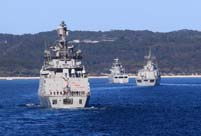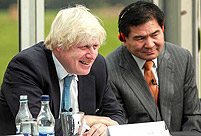BALI, Indonesia Oct. 7 -- As the engine of the global economy shifts to Asia, a greater responsibility is placed on regional groups such as the Asia Pacific Economic Cooperation ( APEC) to drive ahead development, not only for its members but for the world in general.
Such pressure demands greater integration and more cohesive trade, which can be tricky to implement for the 21 members of APEC.
The APEC region is expected to outperform the world with growth forecast to accelerate to 4.7 percent in 2013, according to an APEC policy unit report.
Industrialized APEC members have defied the global trend of moderating economic growth with GDP picking up by 2.1 percent in 2012. This is quite significant given that most industrialized economies are still struggling to avoid recession and have recorded modest growth.
Growth in emerging and developing APEC economies is expected to pick up by 6.9 percent in 2013. Despite this moderation in growth, emerging and developing APEC members remain the fastest growing economy in the world, contributing to more than 55 percent of global real GDP growth.
However, APEC's growth prospects are likely to be influenced by external forces.
In industrialized APEC, both governments and households are expected to tighten spending in order to consolidate their balance sheets. The uncertain global economy, which could translate into lower investment and export growth, could seriously jeopardize the recovery process of these economies.
The uncertain global growth outlook remains the strongest headwind for emerging and developing APEC in 2013.
Economies with large and robust domestic markets and less reliance on exports as a driver of growth will be in a better position to weather the external slowdown. On the other hand, growth is expected to slow sharply among economies with relatively high exposure to the external market but with small domestic consumption bases.
The APEC region as a whole is a net oil-importer. Large and sustained increases in oil prices due to geopolitical concerns in the Middle East could also negatively impact APEC's growth by putting upward pressure on inflation and deteriorating the region' s terms of trade. But it's not all bad news.
"Economic activity in industrialized APEC economies as a whole is forecast to pick up at faster rates than non-APEC industrialized economies," the policy report insists, noting that members such as the United States, China, Australia and New Zealand have shown significant growth due to their links with APEC.
For example, more than two thirds of Australia's total trade is with fellow APEC members, says a new report published by its Department of Foreign Affairs and Trade (DFAT). It lends credence to the fact that building closer multilateral trading bloc helps enhancing investment performance.
The report titled "The APEC Region - Trade and Investment" is part of a series published each year by DFAT on Australia's international trade in goods and services. The latest report highlights the importance of Australia's economic relationship with APEC nations.
With regard to Australia's trade, the DFAT report shows that APEC nations account for almost 57 percent of Australia's investment abroad and nearly 45 percent of foreign investment in Australia.
In terms of Australian investment in APEC member economies, the report finds that investment rose 7.3 percent to 736 billion U.S. dollars. On the other hand investment by APEC member economies in Australia rose 9.3 percent to 970.6 billion dollars.
Such impressive potential is also driving other member countries. This year's host Indonesia is also planning to emphatically call for the inclusion of palm oil and rubber into the extended list of 54 green goods on which tariffs will be capped at 5 percent and eliminated by 2015.
As the world's largest palm oil producer and third largest rubber exporter, Indonesia has been lobbying for this inclusion for years but also has other expectations under its belt, according to the Jakarta Post.
With such attractive prospects it is not surprising that many countries and regions are in the waiting line to gain membership.
India, is one that has been pushing for membership for years, finally gaining observer status in 2011. Pakistan, Bangladesh, Sri Lanka, Macao, Mongolia, Laos, Cambodia, Costa Rica, Colombia, Panama, and Ecuador, are among a dozen economies seeking APEC membership.
The reluctance of APEC to accept new members, especially economically vibrant countries such as India, is one of the key criticisms leveled against the organization. There is also ire from smaller countries that are not allowed membership but have to deal with the consequences of APEC decisions.
Be that as it may, APEC now has to focus on effectively implementing its three pillars, namely, trade and investment liberalization, business facilitation and economic and technical cooperation. All these are essential if the bloc is to continue accounting for more than half the world's GDP and have the capacity to lift millions out of poverty.
Therefore it is clear that the 2013 edition of APEC will have much to achieve for the benefit of the entire world.
 Police officer injured after gunshots outside Capitol
Police officer injured after gunshots outside Capitol 11 countries' warships arrive at Jervis Bay for security exercise
11 countries' warships arrive at Jervis Bay for security exercise Chinese tycoon aims to restore London's Crystal Palace
Chinese tycoon aims to restore London's Crystal Palace A staple of southern Chinese people
A staple of southern Chinese people Portrait of an amateur Waltz dancer
Portrait of an amateur Waltz dancer Tourists take pictures beside Qinghai Lake in Xining
Tourists take pictures beside Qinghai Lake in Xining Travel with photographer- Gansu province
Travel with photographer- Gansu province  Serena Williams stumbles through to quarterfinals
Serena Williams stumbles through to quarterfinals Thailand Mobile Expo 2013 kicks off
Thailand Mobile Expo 2013 kicks off Photo collection of Chinese Navy
Photo collection of Chinese Navy People mourn for victims of mall attack
People mourn for victims of mall attack Twins Culture Festival kicks off in Beijing
Twins Culture Festival kicks off in Beijing UNESCO world heritage site: Montale Tower
UNESCO world heritage site: Montale Tower Li Na vs Novak Djokovic in charity match before 2013 China Open
Li Na vs Novak Djokovic in charity match before 2013 China Open American batman soars through China's Jianglang Mountain
American batman soars through China's Jianglang MountainDay|Week|Month